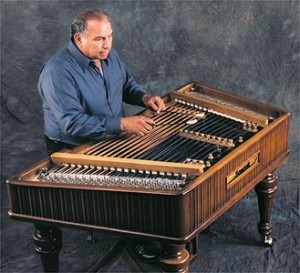Chamber Music Transcriptions of Bach’s Famous Repertoire — Goldberg Variations

Cimbalom
A variation set for harpsichord that’s considered the model of a variation set? Lots of other instrumental players looked at Bach’s Goldberg Variations in envy and immediately started making arrangements for their own instruments. As we saw in the first article on Bach’s famous repertoire, sometimes this works and sometimes it doesn’t.
What happens, then, when you get your friends involved? When you have the Goldberg Variations, as written for 1 keyboard and 10 fingers, transmuted into something for you and three friends? Or two friends? Or just one?
Cimbalom:

Cimbalom with beaters
The Hungarian instrument, the cimbalom, is a kind of hammered dulcimer. The strings are struck with light beaters held in the fingers and the resulting sound is not unlike that of a harpsichord. The problem, of course, is that you can only play with the number of beaters that you hold. This performance with 2 cimbaloms can bring out many of the original voices but can’t match the original 10 fingers.
J.S. Bach: Goldberg Variations, BWV 988 – Aria (arr. for 2 cimbaloms) (Agnes Szakaly, cimbalom; Rozsa Farkas, cimbalom)
Brass Ensemble:
The Canadian Brass’ arrangement of the Goldberg Variations is an interesting mix of sounds. The high brass carries the melody of the aria while the lower brass manages to sound like an organ. This seems to be making an oversimplification of the lower lines – Bach didn’t write this for the organ, he wrote it for the harpsichord. One of the key elements of the harpsichord is that it does not have the ability to sustain pitches, therefore, it can’t sound like an organ!
J.S. Bach: Goldberg Variations, BWV 988 – Aria (arr. A. Frackenpohl for brass ensemble) (Canadian Brass)
String Ensemble:
The Swizz Chamber Soloists use the various timbres of the instruments to bring out the individual lines and avoid making the lower voices into simply organ-like pedal tones.
J.S. Bach: Goldberg Variations, BWV 988 – Aria (arr. D. Sitkovetsky) (Swiss Chamber Soloists)
Saxophone Quartet:
Again, with the Saxophone Quartet, they miss the harpsichord quality of the original and go into a pseudo-organ feeling, with the moving lower voices.
J.S. Bach: Goldberg Variations, BWV 988 – Aria (arr. A. Nagura) (Hardi Saxophone Quartet)
Woodwind Ensemble:
Arranging the work for woodwind ensemble means that we can have a version where the different timbres of the individual instruments can help us hear even the inner voices clearly.
J.S. Bach: Goldberg Variations, BWV 988 – Aria (arr. A. Eshpai) (Homecoming Woodwind Ensemble)
Cello and Organ:
When we have two great masters, Yo-Yo Ma and Ton Koopman, taking on this work, we end up with a performance of tremendous gravitas and nobility. This time, since the other voices are taken over by the organ, we don’t mind if it actually sounds like an organ!
J.S. Bach: Goldberg Variations, BWV 988 – Aria (arr. T. Koopman for cello and organ) (Yo-Yo Ma, cello; Ton Koopman, organ)
Strings and Continuo:
One of the best of the ensemble recordings not only uses a common Baroque ensemble with a basso continuo (here cello and theorbo) but takes the upper voices in only two instruments: a solo violin and a solo viola. The four voices each are able to carry a line of the counterpoint and create an exquisite variation on this most loved of melodies.
J.S. Bach: Goldberg Variations, BWV 988 – Aria (arr. B. Labadie for strings and continuo) (Les Violons du Roy, Bernard Labadie, cond.)
There are many other arrangements of this work, although, oddly, very few for non-classical instruments. It seems still to stand as an icon of classicism. Each new variation on the variation set gives us the opportunity to hear the work anew – hear new voices – hear inner lines – and then, finally, appreciate the true artistry that was in the Bach’s famous repertoire.
For more of the best in classical music, sign up to our E-Newsletter

